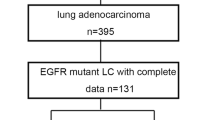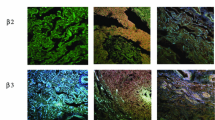Summary
Maspin belongs to the serine protease inhibitor (serpin) family and has been proven to be a suppressor of tumor growth and metastasis in many types of tumors. The purpose of this study was to investigate the expression of maspin in non-small cell lung cancer (NSCLC) and its relationship to vasculogenic mimicry (VM). A total of 160 specimens of NSCLC were involved in this study and 20 specimens of normal lung tissue served as controls. VM, microvessel density (MVD) and the expression of maspin were detected by using immunohistochemical staining. The results showed that the positive rates of maspin and VM in the NSCLC group were 48.1% (77/160) and 36.9% (59/160), respectively, which were significantly different from those in the control group with the positive rates of maspin and VM being 100% and 0% respectively (P<0.05). VM, MVD and the expression level of maspin were significantly related to tumor differentiation, lymph node metastasis, clinical stages and postoperative survival time (all P<0.05). The maspin expression in patients with squamous cell carcinoma was significantly higher than that in those with adenocarcinoma (P<0.05). The maspin expression was negatively correlated with VM and MVD, and there was a positive correlation between VM and MVD. Maspin-negative expression, VM and high MVD score were negatively related to the 5-year-survival rate. PTNM stages, VM, MVD and maspin expression were independent prognostic factors for NSCLC (P<0.05). It was suggested that the loss of expression of maspin may participate in the invasion and metastasis of NSCLC and it has a positive relationship to VM in NSCLC. Combined detection of maspin, VM and MVD may help predict the progression and prognosis of NSCLC.
Similar content being viewed by others
References
Jemal A, Center MM, Desantis C, et al. Global patterns of cancer incidence and mortality rates and trends. Cancer Epidemiol Biomarkers Prev, 2010,19(8):1893–1907
Ramalingam SS, Owonikoko TK, Khuri FR. Lung cancer: new biological insights and recent therapeutic advances. CA Cancer J Clin, 2011,61(2):91–112
Zou Z, Anisowicz A, Hendrix MJ, et al. Maspin, a serpin with tumor-suppressing activity in human mammary epithelial cells. Science, 1994,263(5146):526–529
Ngamkitidechakul C, Warejcka DJ, Burke JM, et al. Sufficiency of the reactive site loop of maspin for induction of cell-matrix adhesion and inhibition of cell invasion. Conversion of ovalbumin to a maspin-like molecule. J Biol Chem, 2003,278(34):31796–31806
Odero-Marah VA, Khalkhali-Ellis Z, Chunthapong J, et al. Maspin regulates different signaling pathways for motility and adhesion in aggressive breast cancer cell. Cancer Biol Ther, 2003,2(4):398–403
Liu J, Yin S, Reddy N, et al. Bax mediates the apoptosis-sensitizing effect of maspin. Cancer Res, 2004,64(5): 1703–1711
Zhang W, Shi HY, Zhang M. Maspin overexpression modulates tumor cell apoptosis through the regulation of Bcl-2 family proteins. BMC Cancer, 2005,5:50
Bailey CM, Khalkhali-Ellis Z, Seftor EA, et al. Biological functions of maspin. J Cell Physiol, 2006,209(3):617–624
Sheng S. A role of novel serpin maspin in tumor progression: the divergence revealed through efforts to converge. J Cell Physiol, 2006,209(3):631–635
Khalkhali-Ellis Z. Maspin, the new frontier. Clin Cancer Res, 2006,12(24):7279–7283
Maniotis AJ, Folberg R, Hess A, et al. Vascular channel formation by human melanoma cells in vivo and in vitro: vasculogenic mimicry. Am J Pathol, 1999,155(3):739–752
Sood AK, Seftor EA, Fletcher MS, et al. Molecular determinants of ovarian cancer plasticity. Am J Pathol, 2001,158(4):1279–1288
Heyman L, Leroy-Dudal J, Femands J, et al. Mesothelial vitronectin stimulates migration of ovarian cancer cell. Cell Biol Int, 2010,34(5): 493–502
Zhao XL, Du J, Zhang SW, et al. A study on vasculogenic mimicry in hepatocellular carcinoma. Zhonghua Gan Zang Bing Za Zhi (Chinese), 2006,14(1):41–44
Guzman G, Cotler SJ, Lin AY, et al. A pilot study of vasculogenic mimicry immunohistochemical expression in hepatocellular carcinoma. Arch Pathol Lab Med, 2007, 131(12):1776–1781
Liu WB, Xu GL, Ma JL, et al. Osteopontin as a key mediator for vasculogenic mimicry in hepatocellular carcinoma. Tohoku J Exp Med, 2011,224(1):29–39
Gray DR, Huss WJ, Yau JM, et al. Short-term human prostate primary xenografts: an in vivo model of human prostate cancer vasculature and angiogenesis. Cancer Res, 2004,64(5):1712–1721
Ahmadi SA, Moinfar M, Gohari Moquaddam K, et al. Practical application of angiogenesis and vasculogenic mimicry in prostatic adenocarcinoma. Arch Iran Med, 2010,13(6):498–503
Fan YZ, Sun W, Zhang WZ, et al. Vasculogenic mimicry in human primary gallbladder carcinoma and clinical significance thereof. Zhonghua Yi Xue Za Zhi, 2007,87(3): 145–149
Li M, Gu Y, Zhang Z, et al. Vasculogenic mimicry: a new prognostic sign of gastric adenocarcinoma. Pathol Oncol Res, 2010,16(2):259–266
Vartanian AA, Stepanova EV, Gutorov SL, et al. Prognostic significance of periodic acid-schiff-positive patterns in clear cell renal cell carcinoma. Can J Urol, 2009,16(4):4726–4732
Shirakawa K, Wakasugi H, Heike Y, et al. Vasculogenic mimicry and pseudo-comedo formation in breast cancer. Int J Cancer, 2002,99(6):821–828
Basu GD, Liang WS, Stephan DA, et al. A novel role for cyclooxygenase-2 in regulating vascular channel formation by human breast cancer cell. Breast Cancer Res, 2006,8(6):R69
Yue WY, Chen ZP. Does vasculogenic mimicry exist in astrocytoma? J Histochem Cytochem, 2005,53(8):997–1002
Kumada T, Tsuneyama K, Hatta H, et al. Improved 1-h rapid immunostaining method using intermittent microwave irradiation: practicability based on 5 years application in Toyama Medical and Pharmaceutical University Hospital. Mod Pathol, 2004,17(9):1141–1149
Folberg R, Maniotis AJ. Vasculogenic mimicry. APMIS, 2004,112(7–8):508–525
Toillon RA, Lagadec C, Page A, et al. Proteomics demonstration that normal breast epithelial cells can induce apoptosis of breast cancers through insulin-like growth factor-binding protein-3 and maspin. Mol Cell Proteomics, 2007,6(7):1239–1247
Lonardo F, Li X, Kaplun A, et al. The natural tumor suppressor protein maspin and potential application in non-small cell lung cancer. Curr Pharm Des, 2010; 16(16):1877–1881
Kim S, Han J, Kim J, et al. Maspin expression is transactivated by p63 and is critical for the modulation of lung cancer progression. Cancer Res, 2004,64(19):6900–6905
Nam E, Park C. Maspin suppresses survival of lung cancer cells through modulation of Akt pathway. Cancer Res Treat, 2010,42(1):42–47
Takanamil I, Abiko T, Koizumi S, et al. Expression of maspin in non-small-cell lung cancer correlation with clinical features. Clin Lung Cancer, 2008,9(6):361–366
Ni JT, Yi YF, Shi HP. Expression of maspin, p53 and Skp2 in colorectal tumors and their clinicopathological significance. Chin J Cancer Res, 2009,21(2):147–153
Fan YZ, Sun W. Molecular regulation of vasculogenic mimicry in tumors and potential tumor-target therapy. World J Gastrointest Surg, 2010,2(4):117–127
Zhang S, Guo H, Zhang D, et al. Microcirculation patterns in different stages of melanoma growth. Onclo Rep, 2006,15(1):15–20
Forberg R, Hendrix MJ, Maniotis AJ. Vasculogenic mimicry and tumor angiogenesis. Am J Pathol, 2000, 156(2):361–381
Mineo TC, Ambrogi V, Baldi A, et al. Prognostic impact of VEGF, CD31, CD34 and CD105 expression and tumor vessel invasion after radical surgery for IB-IIA non-small cell lung cancer. J Clin Pathol, 2004,57(6):591–597
Wang MC, Yang YM, Li XH, et al. Maspin expression and its clinicopathological significance in tumorigenesis and progression of gastric cancer. World J Gastroenterol, 2004,10(5):634–637
Sood AK, Fletcher MS, Coffin JE,et al. Functional role of matrix metalloproteinases in ovarian tumor cell plasticity. Am J Obstet Gynecol, 2004,190(4):899–909
Sun B, Zhang S, Zhao X, et al. Vasculogenic mimicry is associated with poor survival in patients with mesothelial sarcomas and alveolar rhabdomyosarcomas. Int J Oncol, 2004,25(6):1609–1614
Wang W, Lin P, Han CH, et al. Vasculogenic mimicry contributes to lymph node metastasis of laryngeal squamous cell carcinoma. J Exp Clin Cancer Res, 2010, 29:60
Nakashima M, Ohike N, Nagasaki K, et al. Prognostic significance of the maspin tumor suppressor gene in pulmonary adenocarcinoma. J Cancer Res Clin Oncol, 2004,130(8):475–479
Author information
Authors and Affiliations
Corresponding author
Rights and permissions
About this article
Cite this article
Wu, S., Yu, L., Cheng, Z. et al. Expression of maspin in non-small cell lung cancer and its relationship to vasculogenic mimicry. J. Huazhong Univ. Sci. Technol. [Med. Sci.] 32, 346–352 (2012). https://doi.org/10.1007/s11596-012-0060-4
Received:
Published:
Issue Date:
DOI: https://doi.org/10.1007/s11596-012-0060-4




